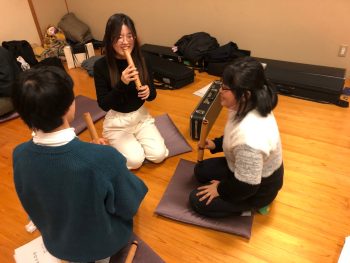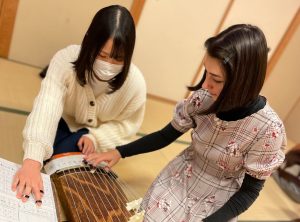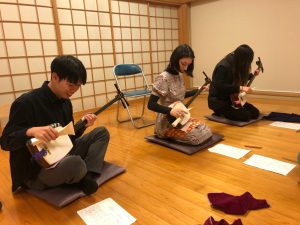A Journey Through Tradition: Experiencing Japanese Music at the Sankyokukai Club
December 1, 2023
On December 1st, a unique opportunity presented itself to Hosei students: a chance to step into the world of traditional Japanese music with the Sankyokukai club. Sankyokukai, literally translating to “three instrument society”, is dedicated to preserving and sharing the beauty of Japanese music through the masterful trio of instruments: the 箏 (koto), 三味線 (shamisen), and 尺八 (shakuhachi).
Each instrument boasts a rich history, intricately woven into the fabric of Japanese culture for centuries.
箏 (koto):
The 箏, a long, stringed instrument resembling a zither, holds an ancestry tracing back to ancient China. Its introduction to Japan began around the 7th century, quickly gaining popularity among the nobility and court musicians. Its gentle, ethereal tones have graced countless classical pieces and folk songs, becoming a cornerstone of Japanese musical expression.
三味線 (shamisen):
The 三味線, a plucked string instrument with three silk strings stretched over a taut skin surface, arrived in Japan from Okinawa in the 16th century. Initially associated with folk music and storytelling, it soon found its way into kabuki and bunraku performances, adding depth and dynamism to the theatrical experience. Its versatility allows for a wide range of sounds, from delicate melodies to energetic rhythms.
尺八 (shakuhachi):
The 尺八, a bamboo flute with five finger holes, possesses a unique sound characterized by its low, haunting tones. Originally used by Zen Buddhist priests for meditation and spiritual practice, its melancholic melodies evoke feelings of peace and serenity. Over time, it transcended its religious roots and found its place in various musical genres, adding a touch of solemnity and introspection.
As the Hosei students entered the Sankyokukai club room, they were greeted by the sight of these instruments, each radiating an aura of tradition and artistry. Under the guidance of experienced members, they embarked on a hands-on exploration of each instrument, learning about its playing techniques and the nuances of sound production.
The culmination of this immersive experience came with the opportunity to learn and play a cherished piece of Japanese music: Sakura (Cherry Blossoms).
Sakura holds a special place in the hearts of Japanese people. The song, with its simple yet poignant melody, captures the fleeting beauty and transient nature of cherry blossoms, a symbol deeply ingrained in Japanese culture. The lyrics, while seemingly straightforward, evoke a sense of nostalgia and reflection, reminding us of the impermanence of life and the preciousness of each moment.
As the students played Sakura together, they were transported to a world of timeless beauty. The delicate notes of the 箏, the expressive plucking of the 三味線, and the introspective sounds of the 尺八 combined to paint a sonic landscape of cherry blossoms in full bloom, a fleeting spectacle that evokes both joy and sorrow.
This experience at the Sankyokukai club provided Hosei students with more than just a musical lesson. It was a window into the heart of Japanese culture, offering a glimpse into the rich history and profound meaning behind traditional instruments and music. It was a reminder that music is not just entertainment; it is a language that transcends words, capable of expressing emotions, sharing stories, and connecting people across generations.
In the spirit of Sakura, the students left the club room carrying not only the melody in their hearts, but also a deeper appreciation for the beauty and ephemerality of life, a message carried on the wings of Japanese music for centuries.



